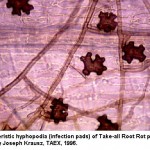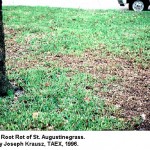Take-all Patch, Bermuda Decline, Take-all Root Rot (fungi – Gaeumannomyces graminis var. graminis or avenae)
Host Grass: Hybrid Bermuda(Cynodon dactylon), Common Bermuda, Bentgrass(Agrostis palustris), Buffalo Grass, ), Centipede Grass, St. Augustine Grass(Stenatophrum secundatum)
Cause and Symptoms:  Take-all root fungus is active in fall and winter when there is abundant moisture and moderate temperatures. However, symptoms are often expressed in late spring or early summer when affected turfgrass first experiences the stressful effects of high temperature and dry weather. This disease has the ability to destroy large sections of turfgrass if left uncontrolled. The first symptom is often yellowing of the leaves which eventually die. Turf becomes thin as roots, nodes and stolons become infected and plants die.
Take-all root fungus is active in fall and winter when there is abundant moisture and moderate temperatures. However, symptoms are often expressed in late spring or early summer when affected turfgrass first experiences the stressful effects of high temperature and dry weather. This disease has the ability to destroy large sections of turfgrass if left uncontrolled. The first symptom is often yellowing of the leaves which eventually die. Turf becomes thin as roots, nodes and stolons become infected and plants die. Unlike brown patch, leaves of take-all infected plants do not easily separate from the plant when pulled. Roots become rotted so damaged stolons are easily pulled from the ground, similar to white grub damage. Regrowth of grass into affected areas is often slow and unsuccessful.
Unlike brown patch, leaves of take-all infected plants do not easily separate from the plant when pulled. Roots become rotted so damaged stolons are easily pulled from the ground, similar to white grub damage. Regrowth of grass into affected areas is often slow and unsuccessful.
Control and Management: Controlling take-all is not easy and both cultural and chemical methods should be considered. Good surface and subsurface drainage is important. Irrigate only when required, and infrequent but thorough water is preferred to frequent shallow watering. Verticutting to remove thatch also helps. Aerification alleviates soil compactions and promotes a deeper, more vigorous root system. Balanced fertility is important. If possible, adjust the soil pH in the upper root zone to a range of pH 6.0 to 6.5. Preventive fungicides (See the section Chemical Controls for Turfgrass Diseases) are best applied in the fall since the fungus is thought to be most active at that time.
Content edited by: Young-ki Jo, ykjo@tamu.edu , Assistant Professor and Extension Specialist, Dept Plant Pathology & Microbiology, Texas A&M University, Texas AgriLife Extension Service, May 31, 2013
